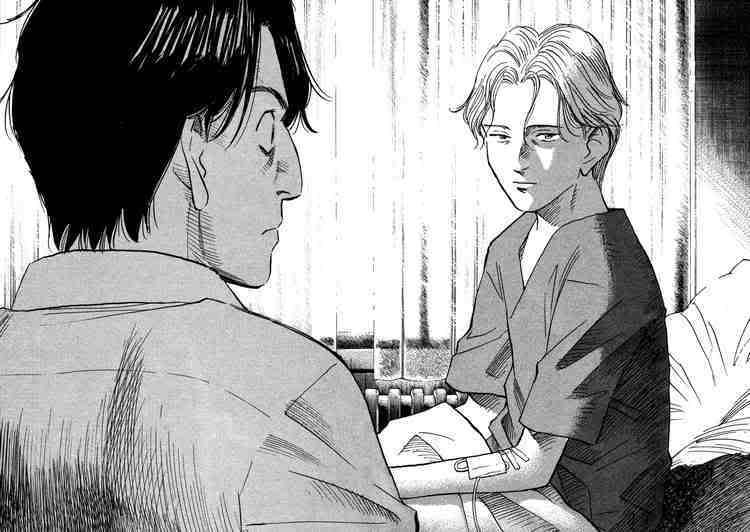 |
| Naoki Urasawa's Monster |
"Comic Books are American, and manga are Japanese."
The first argument annoys me a little. I always found that a little odd, since French and British ones are also called "comics". It seems that we only differentiate between Western and Asian comics, because we only have the word "comic" western art, and manga, manhua, and manhwa for Japanese, Chinese, and Korean comics, respectfully. This "line" between western and eastern gets especially murky sometimes. Is Spiderman made in Japan a "comic" or a manga, in America? Is Dramacon a "manga" or "comic"? The Answers: Spiderman would be called a "comic" and Dramacon (Although it's American), would be considered a manga. The country of origin is always overlooked in these cases."Comic books have Western Art, and manga have ...manga art."
It's expected that comics have "comic art" and manga has "manga art". Honestly, I can't tell the difference between the two at all. I only pay attention to what the artist distorts, and how they render certain details. Each artist has an individual style, so I can't say what is "comic art" and what is "manga" art.There are plenty of Japanese artists who draw "comic book" style and plenty of American artists who draw "manga style". However, the country of origin argument gets brought up again. “Manga” with realistic art like Naoki Urasawa's Monster is still overlooked because they are not American; non-manga looking comics are automatically comic books. It’s a losing battle.
~~
They have minor differences between them, as do all things from different countries, but I don't understand calling them "comic book" in their native language. We (most Americans) speak ENGLISH. Generally, when speaking in English, I use mostly English words. We don't usually call German chocolate schokolade, and French chocolate chocolats, we just say "German chocolate" or "French Chocolate". It's fairly easy to say "Japanese comic book", so why do we give it a whole new word in English?
Hmm, you do have points that I agree with, yet there are other points to this argument as well. As for something like Drama-con, that's actually classified by most as an OEL Manga (Original English Language). As for your Spider-man example, there actually is a Spider-Man manga that came out in the seventies. Seeing as it's called, "Spider-Man: The Manga", they classify things like that as well.
ReplyDeleteJust like manhwa/manhua, there is a distinction. A lot of it, to me personally, is the original artist intent. There is a different feel to the story/characters depending on it's origin. Another little difference is that manga are usually published in anthologies (whether with other manga or all its own) whereas comics usually come in issues of a single story or as a graphic novel. Graphic novel releases are closer to the manga feel, though they're usually a bigger print and, in more recent decades, in color. It's hard for me to describe, sorry, but just the way a release is put together has a different feel depending on the origin.
I do think if we're going to classify, we should give European comics their own term; it's only fair.
Also, Monster, despite you saying it has more realistic art, is still so very, very Japanese looking. The noses, hair, eyes, and even the tone they choose to add shadows to the panels are very recognizeable as a Japanese style. The themes of the story are also very Japanese. So it's a manga. :)
Now, if an American grew up in Japan and was raised there in a Japanese fashion and they created a "drawn story", I would probably call it a manga as there would be the same feel to it. Same with the opposite if a Japanese person was raised in the West all their life and decided to create a "drawn story" -- I'd probably consider it a comic or OEL manga (if they attempted a manga style of art). Where you're raised and the traditions/themes instilled in a person very much effect the feel of their work, which is how I classify in general (there will always be exceptions, but I'm looking at the general rule here).
This is simply how my thought process goes. Just giving you a glimpse on the other side of your thoughts. So, at least for me, "drawn stories" from different places have different feels to them, which is why I think it's fine to label them differently. Just my opinion though, and I'm happy you have your own. :)
Thanks for the reply. I love getting to see other people's point of view. <3
DeleteI never really noted the themes of Monster as being Japanese, especially since it takes place in a European setting and lacks typical Japanese mannerisms.
Somehow, I feel that eventually, we will have so many words in each language for the same basic thing that it will get confusing. Bringing up my chocolate analogy again, American chocolate, Japanese chocolate, and German chocolate are vastly different, but we still call them "chocolate". @~@